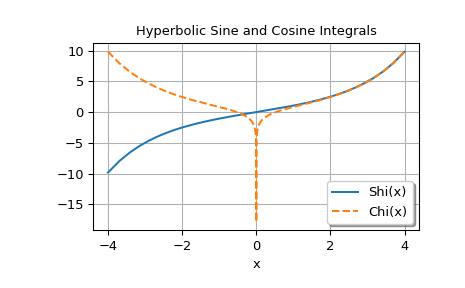scipy.special.shichi#
- scipy.special.shichi(x, out=None) = <ufunc 'shichi'>#
Hyperbolic sine and cosine integrals.
The hyperbolic sine integral is
\[\int_0^x \frac{\sinh{t}}{t}dt\]and the hyperbolic cosine integral is
\[\gamma + \log(x) + \int_0^x \frac{\cosh{t} - 1}{t} dt\]where \(\gamma\) is Euler’s constant and \(\log\) is the principal branch of the logarithm [1].
- Parameters:
- xarray_like
Real or complex points at which to compute the hyperbolic sine and cosine integrals.
- outtuple of ndarray, optional
Optional output arrays for the function results
- Returns:
- siscalar or ndarray
Hyperbolic sine integral at
x- ciscalar or ndarray
Hyperbolic cosine integral at
x
Notes
For real arguments with
x < 0,chiis the real part of the hyperbolic cosine integral. For such pointschi(x)andchi(x + 0j)differ by a factor of1j*pi.For real arguments the function is computed by calling Cephes’ [2] shichi routine. For complex arguments the algorithm is based on Mpmath’s [3] shi and chi routines.
References
[1]Milton Abramowitz and Irene A. Stegun, eds. Handbook of Mathematical Functions with Formulas, Graphs, and Mathematical Tables. New York: Dover, 1972. (See Section 5.2.)
[2]Cephes Mathematical Functions Library, http://www.netlib.org/cephes/
[3]Fredrik Johansson and others. “mpmath: a Python library for arbitrary-precision floating-point arithmetic” (Version 0.19) http://mpmath.org/
Examples
>>> import numpy as np >>> import matplotlib.pyplot as plt >>> from scipy.special import shichi, sici
shichiaccepts real or complex input:>>> shichi(0.5) (0.5069967498196671, -0.05277684495649357) >>> shichi(0.5 + 2.5j) ((0.11772029666668238+1.831091777729851j), (0.29912435887648825+1.7395351121166562j))
The hyperbolic sine and cosine integrals Shi(z) and Chi(z) are related to the sine and cosine integrals Si(z) and Ci(z) by
Shi(z) = -i*Si(i*z)
Chi(z) = Ci(-i*z) + i*pi/2
>>> z = 0.25 + 5j >>> shi, chi = shichi(z) >>> shi, -1j*sici(1j*z)[0] # Should be the same. ((-0.04834719325101729+1.5469354086921228j), (-0.04834719325101729+1.5469354086921228j)) >>> chi, sici(-1j*z)[1] + 1j*np.pi/2 # Should be the same. ((-0.19568708973868087+1.556276312103824j), (-0.19568708973868087+1.556276312103824j))
Plot the functions evaluated on the real axis:
>>> xp = np.geomspace(1e-8, 4.0, 250) >>> x = np.concatenate((-xp[::-1], xp)) >>> shi, chi = shichi(x)
>>> fig, ax = plt.subplots() >>> ax.plot(x, shi, label='Shi(x)') >>> ax.plot(x, chi, '--', label='Chi(x)') >>> ax.set_xlabel('x') >>> ax.set_title('Hyperbolic Sine and Cosine Integrals') >>> ax.legend(shadow=True, framealpha=1, loc='lower right') >>> ax.grid(True) >>> plt.show()
